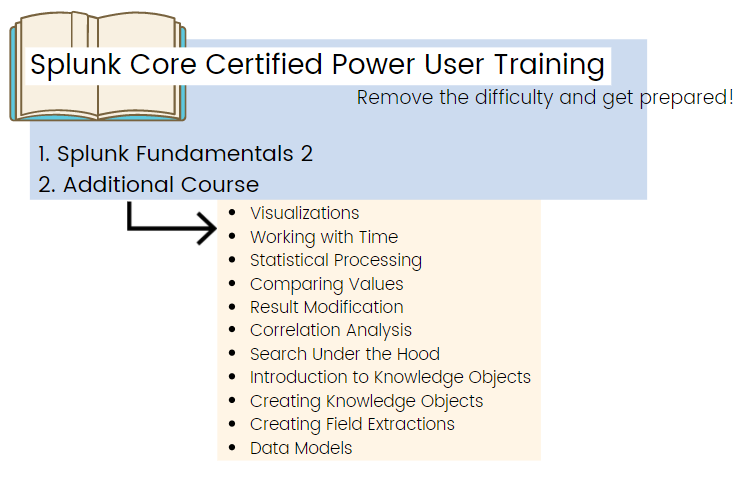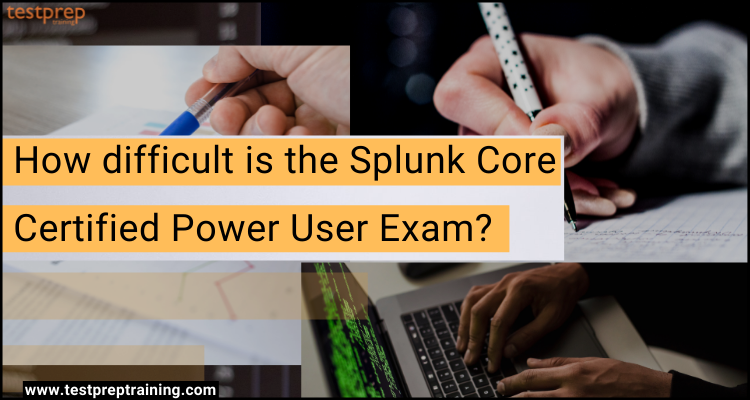The Splunk Core Certified Power User exam is a certification exam offered by Splunk, a leading platform for real-time operational intelligence. Also, the exam tests the knowledge and skills of users who have completed the Splunk Core Certified User certification and have experience using Splunk to search, create reports, and manage knowledge objects.
Furthermore, the exam consists of 60 multiple-choice and multiple-response questions, which must be completed within 90 minutes. The exam covers a range of topics related to Splunk, including searching and filtering data, creating reports and dashboards, managing knowledge objects, using field aliases and macros, and working with lookup tables.
Splunk Core Certified Power User Exam Glossary
Here are some key terms and concepts that you may encounter on the Splunk Core Certified Power User exam:
- Splunk: A software platform for searching, analyzing, and visualizing machine-generated data.
- Indexes: A storage location for Splunk data. Splunk indexes are organized by time and contain the data that is searchable and available for reporting.
- Searches: Queries that you run in Splunk to retrieve data from your indexes.
- Search language: The syntax used to create searches in Splunk. Examples of search language include commands, functions, and operators.
- Field: A specific piece of data within an event in Splunk. Fields can be used to filter, group, and analyze data.
- Event: A data record in Splunk that contains one or more fields.
- Reports: Visual representations of data that you can create in Splunk. Reports can include charts, tables, and graphs.
- Dashboards: Customizable collections of reports, charts, and other visualizations that allow you to monitor key performance indicators and other important metrics.
- Knowledge objects: Configurable objects in Splunk that can be used to improve search performance, automate data analysis, and enrich search results. Examples of knowledge objects include field extractions, macros, and lookup tables.
- Data models: Hierarchical structures that you can use to organize your data in Splunk. Data models help you to create more powerful searches and reports by defining relationships between fields and events.
It’s important to have a solid understanding of these concepts in order to succeed on the Splunk Core Certified Power User exam. Make sure to review the exam objectives and study materials provided by Splunk to prepare thoroughly.
Splunk Core Certified Power User Study Guide
Here are some resources and links that you can use to prepare for the Splunk Core Certified Power User exam:
- Splunk Training: Splunk offers a variety of training courses, both online and in-person, to help you learn how to use Splunk. The Splunk Core Certified Power User certification track includes the Splunk Core Certified User and Splunk Core Certified Power User courses, which are available on the Splunk website.
- Splunk Documentation: The Splunk documentation is a comprehensive resource for learning about Splunk, including how to use the platform and its various features. The documentation includes user manuals, administration guides, and developer guides.
- Splunk Answers: Splunk Answers is a community-driven forum where users can ask questions and receive help from other users. This is a great resource for troubleshooting issues and learning about best practices.
- Splunk Blogs: Splunk offers several blogs that cover topics such as security, IT operations, and data analytics. These blogs can help you stay up-to-date on the latest trends and best practices in the industry.
- Practice Exams: Several websites offer practice exams for the Splunk Core Certified Power User exam. These exams can help you to identify areas where you may need to focus your study efforts and get comfortable with the exam format.
- Splunk User Groups: Splunk User Groups are local communities of Splunk users who come together to learn and share their experiences. Attending a user group meeting can help you to connect with other users and learn new tips and tricks.
Understanding the Splunk Core Certified Power User Exam Difficulty
We cannot say whether the Splunk Core Certified Power User Exam is easy or difficult as this totally depends on how unique your preparation is and what study resources/training you are using. But, one thing that we can help you with is to create a better study plan. However, as we know that The search and reporting commands, as well as the construction of knowledge objects, are covered in the Splunk Core Certified Power User Exam. This exam requires a strong focus on:
- converting commands and visualizations
- filtering and formatting results
- correlating events
- creating knowledge objects
- using field aliases and calculated fields
- creating workflow actions and data models
- normalizing data using the Common Information Model (CIM).
And, to get a better understanding of these, Splunk suggests various training courses. Before learning about these courses, let’s take a look at the exam topics.
Splunk Core Certified Power User Exam Topics
- Using Transforming Commands for Visualizations
- Filtering and Formatting Results
- Correlating Events
- Creating and Managing Fields
- Creating Field Aliases and Calculated Fields
- Create Tags and Event Types
- Creating and Using Macros
- Create and Using Workflow Actions
- Creating Data Models
- Using the Common Information Model (CIM) Add-On
Splunk Recommended Training: Time to level up preparation!
This section is exactly as important as the exam subjects. That is to say, the modules in these training courses are directly link to the exam topics, making it easier for you to grasp the ideas.

• Splunk Fundamentals 2
The search and reporting commands, as well as the generation of knowledge items, are cover in this course. This covers topics like:
- Using transforming commands and visualizations
- Correlating events
- Creating knowledge objects
- Using field aliases and calculated fields
- Creating tags and event types
- Using macros
- Creating workflow actions and data models
Some additional courses!
• Visualizations
This eLearning course teaches the process of using Splunk’s Search Processing Language and the Splunk Web interface for generating visualizations. Moreover, you will gain skills for displaying data on charts and graphs, translating geographic data into maps, creating single value visualizations, and modifying the look of statistical tables using Splunk’s visual formatting choices.
• Working with Time
This three-hour session is designed for advanced users with the aim of mastering the use of time in searches. This covers searching and formatting time, as well as utilizing time commands and working with time zones.
• Statistical Processing
This three-hour session is designed for advanced users with the aim of learning the process of recognizing and applying converting commands and eval functions for generating statistics on their data. This covers rename and sort commands, as well as data series kinds, major transforming commands, mathematical and statistical eval functions, using eval as a function, and using eval as a function.
• Comparing Values
This three-hour course is for advanced users who want to learn the process of utilizing eval functions and eval expressions for comparing field values. Further, this covers
- eval command’s comparison and conditional features
- employing eval expressions with the field format and where commands.
• Result Modification
This three-hour session is for advanced users who want to alter output and normalize data using commands. Specific instructions for altering fields and field values, updating result sets, and managing missing data will be covered in detail. Moreover, you will also learn how to normalize fields and field values across numerous data sources using particular eval command functions.
• Correlation Analysis
This three-hour class is designed for advanced users who wish to learn how to compute field co-occurrence and evaluate data from numerous datasets. This covers transaction, append, appendcols, union, and join commands.
• Search Under the Hood
This eLearning course provides students with further information on how Splunk handles searches. Moreover, you will learn about the architecture of Splunk, how search components are separated down and distributed across the pipeline, and how to debug searches when results aren’t coming back as expected.
• Intro to Knowledge Objects
In this course, you will learn how to use several types of knowledge objects to get new insights from their data. Moreover, it will help in mastering the fundamentals of creating knowledge objects, defining their settings, editing, and managing them.
• Creating Knowledge Objects
This training is for knowledge managers who want to learn the process of using the Splunk web interface for generating knowledge items for their search environment. Further, this covers the sorts of knowledge objects, the search-time operation sequence, and the methods for building event types, workflow actions, tags, aliases, search macros, and calculated fields.
• Creating Field Extractions
This three-hour session for knowledge managers covers Field extraction and the Field Extractor (FX) tool. The FX will be used to build regex and delimited field extractions, as well as when particular fields are extracted.
• Data Models
Knowledge managers who want to understand the process of constructing and accelerating data models would benefit from this training. Further, this covers Datasets, constructing data models, utilizing the Pivot editor, and speeding data models.
Evaluate using the Practice Exams
There are a number of platforms that provide Splunk Core Certified Power User Exam practice tests that you may use to assess your exam preparation. Furthermore, you should complete as many practice questions as possible in order to determine which topics are easy for you and which are not. Also, you will be able to focus on the topics that are difficult for you and strengthen your weak areas.
Final Words
If you have the correct information, resources, and a good study strategy, passing the Splunk Core Certified Power User Exam is not difficult. You will be able to pass the exam with appropriate preparation and effort. However, you must enhance your abilities and utilize the necessary study resources in order to accomplish so. You don’t have to worry about anything because Splunk provides everything you need for the test, from training to retakes. Simply maintain your concentration on passing the exam.



